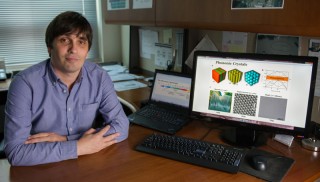Nov 15 2013
Imagine living on a bustling city block, but free from the noise of car horns and people on the street. The emerging field of phononics could one day make this a reality.
 Martin Maldovan, of the Georgia Institute of Technology, has published a review article on phononics in Nature. Credit: Rob Felt.
Martin Maldovan, of the Georgia Institute of Technology, has published a review article on phononics in Nature. Credit: Rob Felt.
The phonon, like the photon or electron, is a physical particle that travels like waves, representing mechanical vibration. Phonons transmit everyday sound and heat. Recent progress in phononics has led to the development of new ideas and devices that are using phononic properties to control sound and heat, according to a new review in Nature.
One application that has scientists buzzing is the possibility of controlling sound waves by designing and fabricating cloaking shells to guide acoustic waves around a certain object – an entire building, perhaps – so that whatever is inside the shell is invisible to the sound waves.
The future possibilities for phonons might also solve the biggest challenges in energy consumption and buildings today. Understanding and controlling the phononic properties of materials could lead to novel technologies to thermally insulate buildings, reduce environmental noise, transform waste heat into electricity and develop earthquake protection, all by developing new materials to manipulate sound and heat. These ideas are all possible in theory, but to make them a reality, phononics will have to inspire the same level of scientific innovation as electronics, and today that’s not the case.
“People know about electrons because of computers, and electromagnetic waves because of cell phones, but not so much about phonons,” said Martin Maldovan, a research scientist in the School of Chemical and Biomolecular Engineering at the Georgia Institute of Technology.
Maldovan’s review article appeared online Nov. 13 in the journal Nature. In the article he blends eight different subjects in the field of phononics, describing advances in sonic and thermal diodes, optomechanical crystals, acoustic and thermal cloaking, hypersonic phononic crystals, thermoelectrics and thermocrystals.
These technologies “herald the next technological revolution in phononics,” he said. All of these areas share a common theme: manipulating mechanical vibrations, but at different frequences.
The hottest fields in phononics, Maldovan said, is the development of acoustic and thermal metamaterials. These materials are capable of cloaking sound waves and thermal flows. The phononics approach to cloaking is based on electromagnetic cloaking materials that are already in use for light.
Maldovan, formerly a research scientist at the Massachusetts Institute of Technology, also conducts phononics research of his own. This past summer, Maldovan published an article in the journal Physical Review Letters, describing an invention for controlling the conduction of heat through solid objects.
Known as thermocrystals, this new area of phononics research seeks to manage heat waves in a similar manner as sound and light waves, by channeling the flow of heat at certain frequencies. The technology could lead to devices that convert heat into energy, or the thermal equivalent of diodes, which could help data centers solve the problem of massive heat generated by their servers.
“The field of Phononics is relatively new, and when you have something new you don’t know what you will find,” Maldovan said. “You’re always thinking ‘what can I do with that?’”
CITATION: M Maldovan. “Sound and heat revolutions in phononics,” (Nature, 2013). DOI:10.1038/nature12608